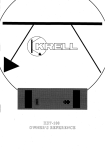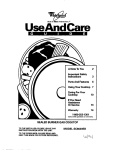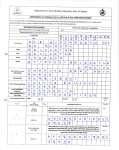Download GE Profile JGP636 Gas Cooktop
Transcript
INSTALM’TION INSTRUCTIONS Before you begin— Read these instructions these instructions IMPORTANT-OBSERVE Note to Installer-Be Note—This completely these instnzctions must be properly with the Consumer. with your Use and Care Book for future reference. grounded. .. ......... ...... . . .. . .. . . ..... . .... . WARNING: If the information ‘inthis manual is not followed exactly, a fire or explosion may resu[t causing property damage, personal injury or death. — — ● In Canada, electrical grounding must be in accordance with the current CSA/C22. 1 Canadian Electrical Code Part 1 and/or local codes. See Electrical Connections. not store or use ~ascke or other flammable vapors and fiquids in the vicinity of this or any other appliance. “ Be sure (he installation of this cooktop in a mobile home conforms with the .Manufactureci 130me Cons[rur tion and %lkly S(andarci, Title 24 CFI<, [)art 3280. If lli:s Stanciarci does Ilot apply, you must fo]]ow’ the standfir(i for .Manufactured I-iorne installations AYSI .X225. 1 an(i .Manufactured Home Installations, Si(es. and Communities ANSI /NFPA 501A or with local codes. WHAT TO DO IF YOU SMELL GAS ● ● ● — ● This cooktop must be electrically grounded in accordance with local codes, or in their absence, with d:e National Electrical Code ANSI/NFPA No. 70-Latest Edition. See Grounding Instructions on page 6. ‘ Do ● Do not try to light anY afmliance. .Do not touch any electrical switch: do not use any ph&e in your building. hnmediately tail your gas s~plier from a neighbor% Phone. Follow the gas supplier’s inskctions . In Canada. mobile home installation must be In accordance w;ih the current C/WT/CSA 22-10/311+Ilobile Home Installation Code. lf you cannot reach your gas supplier, call the fire department lnstailatian and service must performed by aqudifiedinstaller, agency or the gas suppfier. IMPORTANT SAFETY use. CODES AND ORDINANCES. sure to leave these instructions appliance NEW and carefully. for locai inspector’s ALL GOVERNING Note to Consumer—Keep YOUR GAS CX)OKTO Hum IMFORTANT4ave FOR ● Do not store Items of interrst to children in cabinets above the rook[op. TIley coLI1d I)e serioL]sly b~lmcci climbing on (he rooktop to reach !I)cfll. be sewice c To eliminate reaching over surlhce t)[lrners, storage above burner should be avolde(i. (’2~)i Ilt’[ ● Adjust surface burner ilame sue so ]( (im:s r)ot t>xle:!~i beyon(i the edge of the cooking u[ensil. INSTRUCTIONS s ~3ie\rer use your cooktop for warllllr]C or llea[il~: [llc room, Prolonged use of the cooktop \vlt~loLiLadeqLlate L’entdation can be hazardous, This cooktop has been design certified by The American Gas Association according to ANSI 221.1 latest edition and The Canadian Gas Association according to C.&N/ CGA- 1.1 Latest Edition. You’ll find safety precautions in your Use and Care book. Read them carefully. TOOLS YOU WILL NEED For cutting countertop—saber saw For gas supply connection—pipe wTenches For conversion from Natural to Propane ~as—acij~lst:~blc open-end \vrench and 7mm socket driver or 9/32’ nuldriver For burner Ilaxllr :ldjL]s[rllent—I)llilli[)s hea(i :In(i i;lcl,ic type scrc~vcint”ers Installation of this cooktop must conform with local codes, or in the absence of local codes, with the INationai Fuel Gas Code, .&ITSI 2223.1 -Latest Edition. ● ● In Canada. installation must conform with [he cur-rent Natural Gas Inst.aJlation Code. C.-LY/CG.+E3149.1 or the current Propane Installation Code, C.YX,’ CGA-B149.2. and ;vlth local codes \vhere applicable. ADDITIONAL MATERIALS YOU MAY NEED ● Be sure your cooktop is lnstaIled properly l)]” a qualified installer or serivce technician. Gas 1 line shLl[-oif J’al\’e : Pipfe; olrlt s 11 2“ pIpCJ nlpl)ie srai.ln[ Provide adequate clearances between cooktop and adjacent combustible surfaces. For fkxible . I I 35 1/2’ ● I I I I I For connection where local codes permiti Flexible metal tubing (same 3/4” or 1/2” I.D. as gas supply line) Adapter or union rigid connection: Pipe fittings as required. STEP 2: PROVIDE ADEQUATE GAS SUPPLY 1- This cooktop is designed to operate on natural gas at 4“ of water column pressure. It is shipped from the factory set for natural gas. ~..aL#, FOR PROPER OPERATION, THE MAXIMUM INLET PRESSURE ‘IO THE REGULATOR MUST BE NO MORE THAN 14” OF WATER COLUMN PRESSURE. For checking the regulator, the inlet pressure must be at least 1” (or 3.4 KPA) greater than the regulator output setting. If the regulator is set for 4“ of water column pressure, the inlet pressure must be at least 5“. If the regulator is set for 1O“, the inlet pressure must be at least 1l“. 2 1/4” % The gas supply line to the cooktop should be 1/2” or 3/4” pipe. In Canada, flexible connectors must be single walI metal connectors no longer than 6 feet in Iength. 1 “ FROM BACKWALL I JI t- V PROPANE GAS ADJUSTMENTS NOTE: The pressure regulator is set for natural gas. To use Propane Gas, the regulator must be converted. 12 1/2”+ T FROM CUTOUT CENTER LINE I I I I I i 30”MIN. TOCABINET 1, I 1 3 3/4” MIN. I CLEARANCE L 18’MIN. ‘TO CABINET Make sure the w~ coverings, countertop and cabinets around the cooktop can withstand the heat (Lip to 200°F) generated by the cooktop. 2 MAKING L.P. /PROPANE CONVERSION 4. Change the cooktop burner orifices by: A. Removing the top grates, burner caps and burner heads. To adjust your range for use with L. P./Propane follow these instructions: 1. Disconnect all electrical breaker or fuse box. gas, BURNER power, at the main circuit 2. Shut off the gas supply to the range by closing the manual shut-off valve. 3. Adjust the Pressure GRATE BURNER CAP Regulator by: BURNER HEAD CAP GASKET P.,o.yx? I . . r BURNER BOWL ~ SPRING RETAINER / L.PJPROPANE POSITION “**mmm r----, q.-----, ..-4 --- 1, I I I ‘y’ + \------- 1====, I I I I--”,_. I I I I ---‘--’ -- i ---- l====; I I I i----l PRESSURE i\ 11 Iy REGULATOR A. Unscrew the cap. B. Place your thumb against the flat side of the spring retainer and press down to remove the retainer. C. Carefully look at the spring retainer to locate the NAT or L. P./Propane position. D. Turn the spring retainer over so that L. P./ Propane is showing on the bottom. E. Snap the retainer back into posi(ion. 3 SPARK IGNITER ER TUBE (CHIMNEY) B. Remove the valve control knobs. 5. Locate the L.P. /Propane orifices C. Through the openings, locate the valve bypass screws located on the lower right side of the valves. The L.P. /Propane oritlces are shipped in the literature package. They will have a digit number and the letter “L” on one side. D. Using a screwdriver, Each orifice will also show a series of engraved marks, (I, 11or III), located on the top. clockwise screw down fully, in a rotation, the brass bypass screw. 00(2 These marks denote the precise location of each orifice to the cooktop burner. GLASS COOKTOP E. Using a 7mm or 9/32” nut driver, remove the top burner orifices. These may be accessed through the burner air/gas mixer tube (chimney). MIXER TUBE (CHIMNEY) NOTE: The ofilces have a spring loaded retaining ring around the hex head to hold the ori~lce in the nut driver during installation and removal. A slight amount of force is required to push the nut driver down over the ring. !3 RETAINER RING SPECIAL NOTE: To convert the range back to natural gas, use the orifices that you removed during the L.P./ Propane conversion and reverse steps 1-6 of the L. P./ Propane conversion section. 6. Install the L. P./Propane locations. PORCELAIN orifices in their precise COOKTOP Adjust the low [lame setting using the valve bypass scre’,v as follows: Lo\v setting adjustments must be made with t~vo other burners in operation on a medium setting. This procedure pre~rents the low flame from being se[ too low resulting in the flame belnq extinguished ~vhen other burners are turnecl on. IMPORTANT Remove all packing material and literature from cooktop before connecting gas and electrical supply to range. FOR INSTALLATION OVER A BUILT-IN OVEN: See Buiit-in Oven Installation for complete instructions. STEP 3: CONNECT THE COOKTOP TO GAS 1. Connect the cooktop to the gas suppIy line. 2. Install a manual shutoff valve in the gas line in an easily accessible location outside the cooktop. Be sure you know how and where to shut off the gas supply to the cooktop. r19 5“ TO CENTER OF 2“ DIA W FROM COUMERTOP 1/2” CUTOUT-q g&/ STREET EL 3“ 14 L CABIN= SiD STEP 4: ELECTRICAL CONNECTION Electrical L 3. Check for leaks. After connecting range to gas, check system for leaks with a manometer. If a manometer is not available, turn the gas supply on to the range and use a liquid leak detector at all joints and connections to check for leaks. Tighten all connections if necessary to prevent gas leakage in the range or supply line. Check alignment of valves after connecting the range to the gas supply to be sure the manifold pipe has not been moved. A misalignment could cause the valve knob stem to rub on the control panel, resulting in a gas leak at the valve. Disconnect this range and its individual shutoff valve from the gas supply piping system during any pressure testing of that system at test pressures greater than 1/2 psig. Isolate the range from the gas supply piping system by closing its individual shut off valve during any pressure testing of the gas supply system at test pressures equal to or less than 1/2” psig. Requirements: Because of potential safety hazards under certain conditions we strongly recommend against the use of an extension cord. However, if you still elect to use an extension cord, it is absolutely necessary that it be a UL listed 3-wire grounding type appliance extension cord and that the current caqing rating of the cord in amperes be equivalent to or greater than the branch circuit rating. Such extension cords are obtainable through your local appliance dealer. GROUNDING ~ IMPORTANT: (Please read carefully) FOR PERSONAL SAFETY, THIS APPLXANCE MUST BE PROPERLY GROUNDED. The power cord of this appliance is equipped with a three-prong (grounding) plug which mateswith a standard three-prong grounding wall receptacleto minimizethe possibilityof electricshock hazard from this appliance. The customer should have the wall receptacle and circuit checkedby a qualKled electricianto make sure the receptacleis properlygrounded. UNLESS THE SCREW IS METAL, AND NOT INSULATED, AND THE WALL RECEP17ACLE IS GROUNDED THROUGH THE HOUSE WIRING. l%IE CUSTOMER SHOULD HAVE THE CIRCUIT CHECKED BY A QUALIFIED ELECTRICIAN K) MAKE SURE THE RECEPTACLE IS PROPERLY GROUNDED. When disconnecting the power cord fmm the adaptor, always hold the-adaptor with one hand. If this is not done the adaptor ground terminal is very likely to break with repeated use. Should this happen, DO NOT USE the appliance until a proper ground has again been established. USAGE SITUATIONS WHERE APPLIANCE POWER CORD WILL BE DISCONNECTED FREQUENTLY. Insure proper ground and firm connection before use. Do not use an adaptor plug in these situations because disconnection of the power cord places undue strain on the adaptor and leads to eventual failure of the adaptor ground terminal. The customer should have the two-prong wall receptacle replaced with a three-prong (grounding) receptacle by a qualified electrician before using the appliance. Where a standard two-prong wall receptacle is encountered, it is the personal responsibility and obligation of the customer to have it replaced with a properly grounded three-prong wall receptacle. In Canada, mobile home installation must be in accordance with the current CAN/CSA Z240/MH Mobile Home Installation Code. DO NOT, UNDER ANY CIRCUMSTANCES, CUT OR REMOVE THE THIRD (GROUND) PRONG FROM THE POWER CORD. STEP 5: INSTALLING UNIT IN A STANDARD OR TILE COUNTER USAGE SITUATIONS WHERE THE APPLIANCE POWER CORD WILL BE DISCONNECTED INFREQUENTLY. Before installing the unit in the cutout, attach the adhesive backed foam tape (shipped with unit) around the bottom surface of the glass, near the edge of the maintop. For 15 amp circuit only, do not use an adaptor on a 20 amp circuit. Where local codes permit, a TEMPORARY CONNECllON maybe made to a properly grounded two-prong wall receptacle by the use of a UL listed adaptor available at most hardware stores. The larger slot in the adaptor must be aligned with the large slot in the wall receptacle to provide proper polarity in the connection of the power cord. To attach the unit to the counter, insert the hold down brackets in the slots on each side of the unit. Use the screws supplied to attach unit to counter as shown. The unit must rest on the metal flange arounci the burner box and not on the glass. MOUNTING Insure proper ground and firm connection before use. , BOX P+fj 10 d ‘ “. I/ O:“~ / j2’i+.usE Align large prongs/slots SUITABLE , l! /1 Temporary method (Adaptor plugs not permittedin Canada) Yj CAUTION: ATllACHING THE ADAPTOR GROUND TERMINAL ~ THE WALL RECEPTACLE COVER SCREW DOES NOT GROUND THE APPLIANCE SIDES 0 ‘, . FASTENERS FOR ANCHORING IN CABINET SIDES STEP 6: ASSEMBLING THE COOKTOP BURNERS STEP 7: CHECK THE IGNITERS Operation of electric igniters should be checked after cooktop and supply line connectors have been carefully checked for leaks and cooktop has been connected to electric power. Place the bumerhead onthebumerkwl, so that the location of the spark igniter matches up with the opening in the burner head. Position the burner cap on the burner head. Place the burner grate over the burner assembly and into the burner bowl. The bottoms of the burner grates have fingers that fit into the corresponding indentations in the burner bowl. BURNER GRATE o T <—. II,4 To check for proper lighting, push in and turn a burner valve to the LITE position. The burner valve should light when gas is available to burner. Once the burner lights, it should be turned out of the LITE position. TV each valve separately until all burners have been checked out. BURNER IGNITION COOKTOP SPARK IGNITION — When you turn the cooktop knob to LITE, the spark igniter makes a series of electric sparks (ticking sounds) which light the burner. During a power failure the burners will not light automatically. In an emergency, a cooktop burner may be lit with a match by following the steps below, BURNER CAP <— BURNER HEAD SPARK IGNITER BURNER BOWL ~ ER TUBE (CHIMNEY) Turn each burner full on. Flames should be blue in color with no trace of yellow. Foreign particles in the gas ]ine may cause an orange flame at first but this will soon disappear. The burner flames shoulcl not flutter or blow a~vay from the burner. The inner cone of the Ilame should be between 1/2” and 3/4” long. 1. Light a match and hold the flame near the burner yoLl want to light. Wooden matches work best. 2. push in and turn the control knob slowly. Be sure you are turning the correct knob for the burner yoLl are lighting. NOTE: If the burner does not light within five seconds, turn the knob off and wait one minute before trying again. STEP 8: WHEN ALL HOOKUPS ARE COMPLETED MAKE SURE ALL CONTROLS POSITION. ARE LEf7 IN THE OFF MAKE SURE THE FLOW OF COMBUSTION AND VENTILATION AIR TO THE RANGE IS UNOBSTRUCTED. MODEL AND SERIAL NUMBER LOCATION. px::P \ -q 1-1/2” to 3/4” The serial plate for your cooktop is located on the bottom of the burner box. In addition to the model anti serial numbers, it tells you the ratings of the burners and type of fuel and pressure the cooktop was adjusted for when it left the factory. When ordering parts, always include the serial nunlber, model number and code letter to ensure proper replacement parts. Parts may be obtained thI-oLlgh General Electric /HotPoint FactoIy Semite Cerlters or General Electric/Hotpoint authorized Cuslomer Cclre semicers. NOTES Q> ~$ Pub. No. 31-10169 229c4053P03$I RecycJed Paper — Printed in LaFayette, Georgia —











